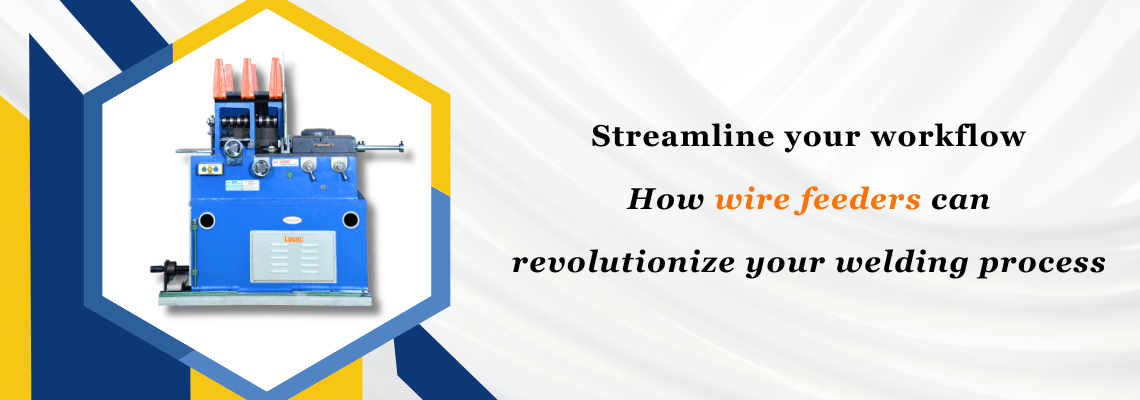In the world of welding, efficiency and precision are key. Whether you’re a seasoned welder or just starting out, streamlining your workflow can make a significant difference in your productivity and the quality of your work. One of the game-changers in this area is the wire feeder. This article delves into how wire feeders can revolutionize your welding process, making your work easier, faster, and more precise.
What is a Wire Feeder?
A wire feeder is a crucial component in welding that supplies the filler material to the welding arc. It ensures a continuous and consistent feed of wire, which is essential for creating strong, clean welds. Wire feeders come in various types, each suited to different welding applications.
Types of Wire Feeders
Mechanized Wire Feeders: These are used in automated welding systems and provide precise control over the wire feed rate.
Portable Wire Feeders: Ideal for mobile or field work, these are lightweight and can be easily transported.
Push-Pull Wire Feeders: These feeders use a two-motor system to push and pull the wire, reducing issues like bird nesting or tangling.
Benefits of Using Wire Feeders
Enhanced Efficiency
Wire feeders can significantly enhance efficiency in the welding process. By automating the wire feed, you eliminate the need for manual feeding, which can be time-consuming and inconsistent. This automation leads to a more streamlined workflow and faster completion of welding tasks.

Improved Precision
Consistency is critical in welding. Wire feeders ensure a steady and precise feed of the welding wire, which translates to more accurate welds. This precision reduces the likelihood of defects and the need for rework, saving both time and materials.
Reduced Operator Fatigue
Manual feeding of welding wire can be physically demanding, leading to operator fatigue. By using a wire feeder, you reduce the physical strain on the welder, allowing them to focus on other aspects of the job and maintain higher levels of productivity.
Better Control Over Welding Parameters
Wire feeders offer better control over welding parameters such as feed speed and tension. This control helps in adjusting the weld according to specific requirements, leading to better overall weld quality.
How to Choose the Right Wire Feeder
Consider the Type of Welding
Different welding processes require different types of wire feeders. For instance, MIG (Metal Inert Gas) welding typically uses a constant wire feed rate, while other processes might require variable feed rates. Choose a wire feeder that matches the specific needs of your welding process.
Evaluate Wire Feeder Capacity
The capacity of the wire feeder, including the wire spool size and feed rate, should align with your welding needs. Larger capacities are beneficial for high-volume welding tasks, while smaller, more portable feeders might be more suitable for fieldwork.
Assess Compatibility with Your Equipment
Ensure that the wire feeder is compatible with your welding machine. Compatibility issues can lead to performance problems and potential damage to your equipment.
Installation and Maintenance Tips
Proper Installation
Correct installation is crucial for optimal performance. Follow the manufacturer’s guidelines for setup and ensure that all connections are secure and properly aligned.
Regular Maintenance
Routine maintenance of the wire feeder is essential to keep it functioning efficiently. Regularly check for wear and tear, clean the components, and replace any damaged parts to prevent downtime and maintain performance.
Conclusion
Incorporating a wire feeder into your welding process can lead to significant improvements in efficiency, precision, and overall workflow. By understanding the different types of wire feeders and their benefits, you can make an informed decision and enhance your welding operations. Whether you’re aiming to reduce operator fatigue, improve weld quality, or streamline your processes, a wire feeder is a valuable investment in achieving these goals.
FAQs
What is the primary function of a wire feeder in welding?
A wire feeder supplies a consistent and continuous feed of welding wire to the welding arc, which is essential for creating strong and clean welds.
How does a wire feeder improve welding efficiency?
By automating the wire feed process, a wire feeder eliminates the need for manual feeding, leading to faster completion of welding tasks and a more streamlined workflow.
Can wire feeders be used for all types of welding?
While wire feeders are commonly used for MIG welding, they can also be adapted for other types of welding, such as flux-cored arc welding, depending on the specific requirements of the welding process.
What maintenance is required for a wire feeder?
Regular maintenance includes checking for wear and tear, cleaning components, and replacing any damaged parts to ensure optimal performance and prevent downtime.
How do I choose the right wire feeder for my needs?
Consider factors such as the type of welding, wire feeder capacity, and compatibility with your equipment to select the wire feeder that best matches your welding requirements.





